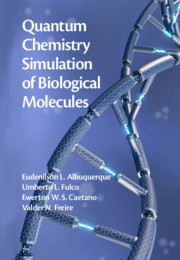Book contents
- Frontmatter
- Contents
- Preface
- Figure Credits
- 1 Basic Properties of Quantum Chemistry
- 2 Charge Transport in the DNA Molecule
- 3 Electronic Transmission Spectra of the DNA Molecule
- 4 Thermodynamic Properties of the DNA Molecule
- 5 Properties of the DNA/RNA Nucleobases
- 6 Molecular Electronics
- 7 Amino Acid Anhydrous Crystals
- 8 Protein–Protein Systems
- 9 Ascorbic Acid and Ibuprofen Drugs
- 10 Cholesterol-Lowering Drugs
- 11 Collagen-Based Biomaterials
- 12 Antimigraine Drugs
- 13 Antiparkinson Drugs
- 14 Central Nervous System Disorders
- 15 The Biology of Cancer
- 16 Concluding Remarks
- Bibliography
- Index
7 - Amino Acid Anhydrous Crystals
Published online by Cambridge University Press: 21 January 2021
- Frontmatter
- Contents
- Preface
- Figure Credits
- 1 Basic Properties of Quantum Chemistry
- 2 Charge Transport in the DNA Molecule
- 3 Electronic Transmission Spectra of the DNA Molecule
- 4 Thermodynamic Properties of the DNA Molecule
- 5 Properties of the DNA/RNA Nucleobases
- 6 Molecular Electronics
- 7 Amino Acid Anhydrous Crystals
- 8 Protein–Protein Systems
- 9 Ascorbic Acid and Ibuprofen Drugs
- 10 Cholesterol-Lowering Drugs
- 11 Collagen-Based Biomaterials
- 12 Antimigraine Drugs
- 13 Antiparkinson Drugs
- 14 Central Nervous System Disorders
- 15 The Biology of Cancer
- 16 Concluding Remarks
- Bibliography
- Index
Summary
Density functional theory computations within the local density approximation and generalized gradient approximation, in pure form and with dispersion correction, were carried out to investigate the structural, electronic, and optical properties of several amino acid anhydrous crystals. The electronic (band structure and density of states) and optical absorption properties were used to interpret the light absorption measurements performed at room temperature. Mulliken and Hirshfeld population analysis were also performed to assess the degree of charge polarization in the zwitterion state of some amino acid molecules in the DFT converged crystal. Different dielectric function profiles obtained for some of the most important symmetry directions also demonstrate the optical anisotropy of the amino acid anhydrous crystals. The infrared absorption and Raman scattering spectra were recorded and interpreted, with their normal modes assigned. The complex role of water on the carrier transport properties in the monohydrated aspartic acid crystals is also highlighted.
Keywords
- Type
- Chapter
- Information
- Quantum Chemistry Simulation of Biological Molecules , pp. 164 - 193Publisher: Cambridge University PressPrint publication year: 2021



